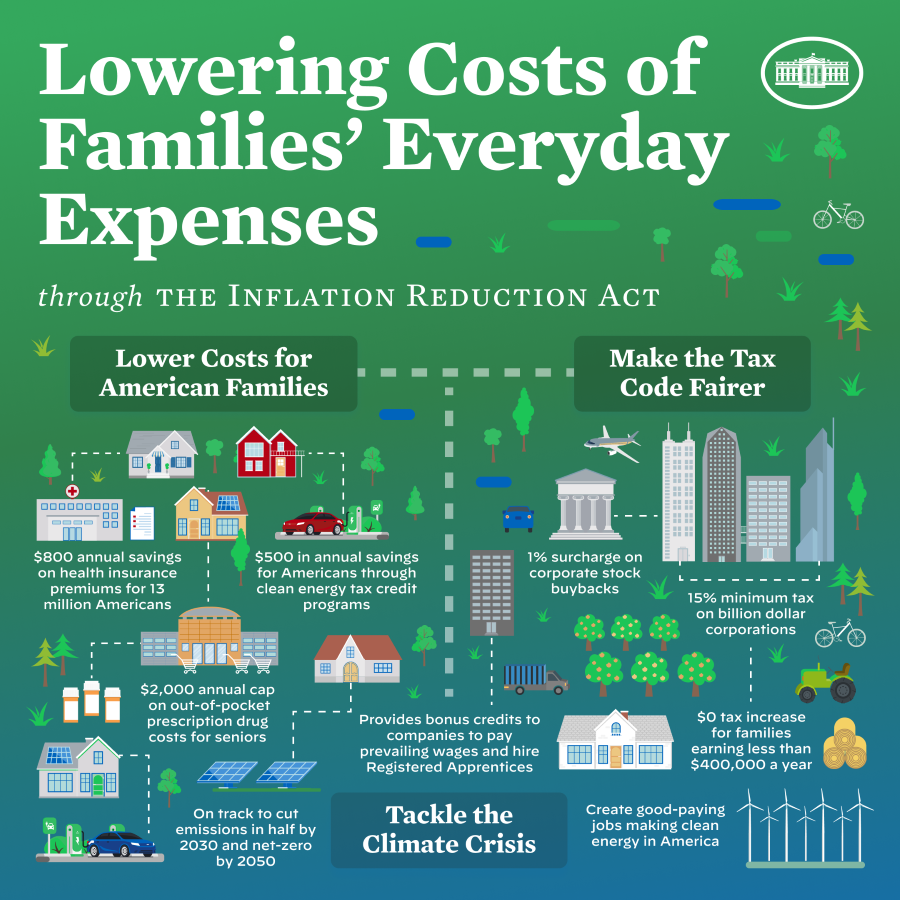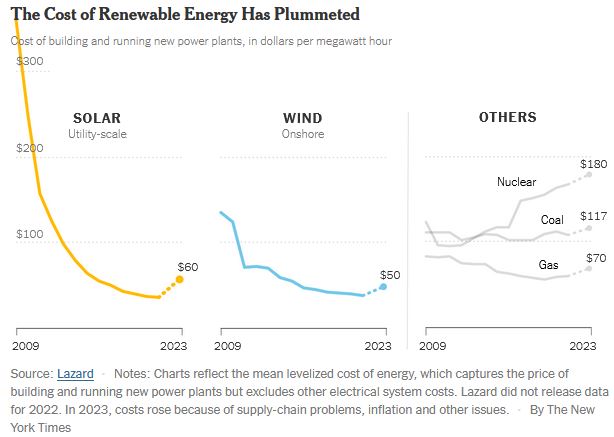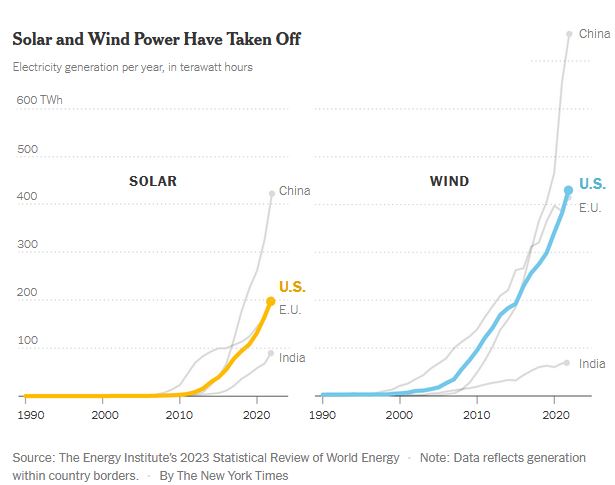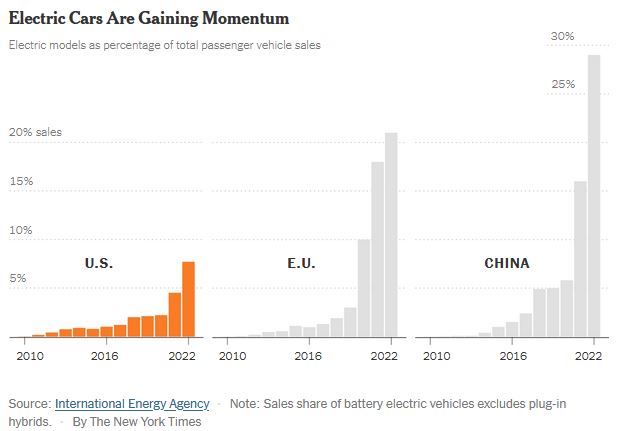
Renaissance of Climate Hope: Our Nation on the Move
By: Chandu Visweswariah
August 16 was the one-year anniversary of the Inflation Reduction Act (IRA), the most significant piece of climate legislation ever passed anywhere in the world. And New York State just announced incentives and subsidies from the Environmental Bond Act (EBA) that all of us helped to pass in November 2022. This financial assistance is additive to Federal IRA assistance. So, what’s the verdict on all this?
In short, there’s never been a better time for decarbonizing action! Let’s try to break all of this down for you.
The IRA was passed on August 16, 2022. It is a deficit-reducing bill that raises revenue from tax reform and the ability to negotiate Medicare drug prices. Most significantly, the bill budgeted $391 billion for energy and climate. The breakup of this money as per the Congressional Budget Office can be summarized as follows: $161 billion for clean electricity tax credits, $40 billion for air pollution, hazardous materials, transportation and infrastructure, $37 billion for individual clean energy incentives, $36 billion for clean fuel and vehicle tax credits, $35 billion for conservation, rural development and forestry, $27 billion for building efficiency, electrification, transmission, industrial, DOE grants and loans, and $18 billion for other energy and climate spending.
There are two aspects of the bill worth understanding. First, the subsidies in the IRA are open-ended. In other words, the actual spending will depend on the popularity of the programs. Goldman Sachs recently estimated that the actual spend on energy security and climate change may well be $1.2 trillion when all is said and done! This is a “use it or lose it” program, and it is up to all of us to take maximum advantage.
Second, the bill (along with the previously passed Infrastructure Act and CHIPS Act) attempts to jump start manufacturing in the United States with an estimated $250 billion in advanced manufacturing tax credits and inclusion of domestic supply provisions in procurement of solar panels, electric vehicle (EV) parts, and so on. In fact, 27 European Union finance ministers expressed “serious concerns” about the IRA, afraid that Europe would lose out on cleantech investment. (Hence, the statement that the IRA is a “give-away to the Chinese” is false and absurd. The truth is that far more wind turbines, far more solar panels, far more batteries and far more EVs are made in China than any other country, and the IRA is our best shot to reverse this trend.)
So, what has been the impact of the bill? The good news is that the impact of the IRA has been more than anyone could have predicted. Consider these factoids:
- As reported in the Wall Street Journal, the U.S. is experiencing an investment boom and received the world’s highest foreign direct investment for two years in a row. In 2022, 22% of global foreign direct investment found its way to the U.S.
- Spending on construction related to manufacturing rose 76% in May 2023 compared to a year earlier.
- Private investment far exceeds Government spending so far, the true hallmark of a good stimulus bill! As of mid-August 2023, companies have announced $76 billion worth of 115 climate-friendly manufacturing investments, eclipsing Government IRA spending thus far! When considered alongside the CHIPS Act, the total private investment is $231 billion, creating a whopping 90,600 jobs (this Wikipedia page has estimates from various sources that are less conservative than these).
- According to the New York Times, spurred by “a gusher of government subsidies,” the country’s clean energy future is coming faster than anyone could have predicted. In a twist, this is happening fastest in red states and states dominated by the oil and gas industry. From the Times article: “The nation that burned coal, oil and gas for more than a century to become the richest economy on the planet, as well as historically the most polluting, is rapidly shifting away from fossil fuels.”
- The International Energy Agency, whose views have historically coincided with the oil and gas industry, said, “It’s astonishing what is happening. Clean energy is moving faster than many people think, and it’s become turbocharged recently.”
So, is it really getting turbocharged? Let’s look at the evidence, starting with renewable electricity. The figure below shows the cost of solar and wind power relative to other sources.

At this time, the cheapest source of electricity is solar or wind power, with a levelized cost of energy of $50 to $60 per megawatt hour, or 5 to 6 cents per kilowatt hour.
Why has this cost come down so dramatically? To really understand this, we need to enter the counter-intuitive world of exponential technology adoption. Both solar and wind benefited in the last three decades from a strong “learning rate,” which is defined as the reduction in cost of manufacturing for every doubling of production volume. This is a kind of virtuous cycle for adoption of a new technology. As volumes go up, economies of scale and innovations lead to lower costs, which in turn increases demand, which in turn increases volumes, which depresses costs even more! Exponential adoption is a truly stunning phenomenon, misunderstood and underestimated even by industry insiders. Once the cost reductions make the new technology less expensive than the incumbent, economics kick in and, with a giant sucking sound, there is a rapid transformation, as is the case with wind and solar worldwide energy production, as shown below.

The same general phenomenon is occurring for batteries and electric vehicles, where the U.S. is behind the E.U. and China, but growing rapidly.

While everyone’s been focused on wind, solar and EVs, heat pumps have been the quiet heroes of decarbonization. In 2022, 53% of heating systems sold were heat pumps, exceeding gas furnaces for the first time and continuing a pattern of double digit annual growth.
In the meanwhile, remember the New York Environmental Bond Act? On November 8, 2022, New Yorkers voted overwhelmingly to provide $4.2 billion for environmental projects. New York State has published guidelines for subsidies for home energy audits, energy efficiency projects, solar, EVs, heat pumps, etc. The good news is that these subsidies are in addition to Federal assistance. There has never been a better time to decarbonize!
To paraphrase scientists’ and environmentalists’ reaction to all this news, “Wow, I can’t believe it is finally happening. About 4 years too late to limit warming to 1.5oC, but if the adoption rate is truly exponential, we still have a shot!”
What does all this mean to the “environmental mission?” No matter what kind of environmental organization you represent, no matter whether your organization’s name has “sustainability” or “conservation” or “climate” or “decarbonization” in it, as explained in our recent blog, we should all be working primarily on decarbonization – it is the urgent need of the hour and the urgent need of the planet.
And how can we be most effective at decarbonization? Very simply by getting rid of fossil fuels.
And what are the most important ways in which we will accomplish this? The three main pillars we need to focus on are transportation, building energy, and electricity, in that order. Beyond that, cooking and diet are the second tier of changes that will move the needle. All other activities (like recycling, waste reduction, composting, gardening, pollinator pathways, natural resource protection), while important in their own right, do not make a noticeable dent in reducing our carbon emissions.
To summarize, the IRA has spurred cleantech investments and accelerated the adoption of wind, solar, heat pumps and electric vehicles. It has put the U.S. on a path to 50% emissions reduction by 2030. The EBA has kicked in additional incentives. With exponential growth of these technologies, costs are down, and the solutions have matured. We are at an exciting moment when the promised “hockey stick” of clean energy adoption is actually happening. As a result, the environmental community is revitalized. Let us rededicate ourselves to decarbonization. Please pledge to never ever buy another fossil fuel vehicle, fossil fuel furnace or fossil fuel appliance (stove, drier, lawnmower, weedwhacker, generator). Reach out to us at https://cure100.org to learn about our “Seven Steps to a Low Carbon Lifestyle!”

